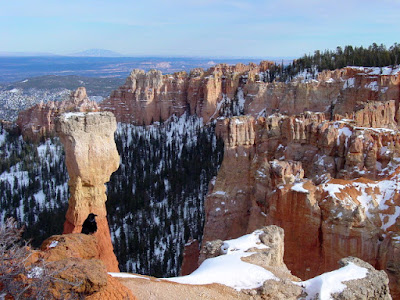Driving to Bryce Canyon from the west, Highway 12 passed through Red Canyon. Many people enjoy Red Canyon more than Bryce Canyon because in Red Canyon you look up at the formations from the bottom and in Bryce Canyon you look down on the formation from the canyon rim. Also, Red Canyon is located in Forest Service Land, so different restrictions apply and there are NO FEES!.
Bryce Canyon, located in Bryce Canyon National Park, despite its name, is not a canyon - it s collection of geological formations called "hoodoos' that are located in a giant natural amphitheater. The hoodoos were formed by weathering and erosion of sedimentary rock that was part of an old lake-bed (same as Red Canon).
This is a popular summer destination because the altitude at the canyon rim varies from 8,000 to 9,000 feet above sea lever. Snowshoeing and cross-country skiing are allowed in the Park during the winter months, but the trails are primarily limed to the rim area or they require special mountaineering equipment. The Winter Festival is held each year over President's Day Weekend and there are many special events to attract winter visitors. (Visit the Park Service web site if you plan a winter visit.)
We have visited Bryce Canyon several times during the summer months, but this is the only winter trip that we have ever made. (Pictures were taken several years ago.) The winter trip was enjoyable; but I still prefer the summer months because then I can hike down into the amphitheater and walk between the hoodoos.
Mossy Cave is reached from Highway 12, but it is still part of the Park. It is a beautiful hike to the cave anytime of year, but especially nice during the winter months because of the ice columns. They tell me that some years the cave ice lasts well into the summer months, but I have never found any ice in the cave when I have been there in the summer.
The trail to the cave follows an old irrigation canal that was built from 1890-1892 by pioneers using only picks and shovels. Water still flows through the canal to supply water to the communities of Tropic and Cannonville that are located downstream.































No comments:
Post a Comment